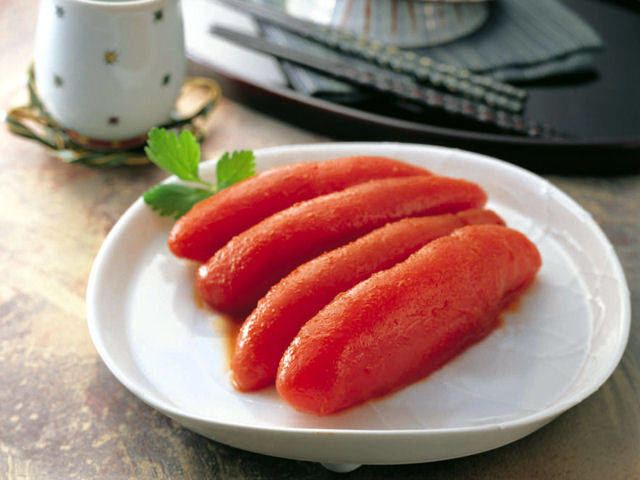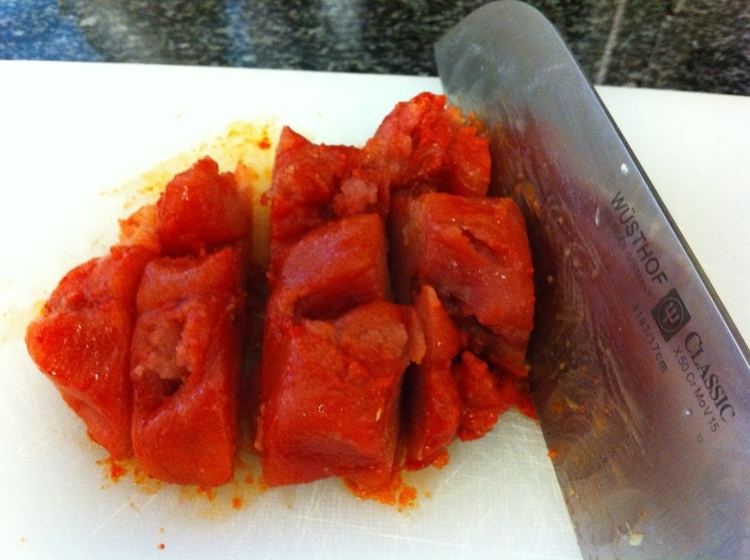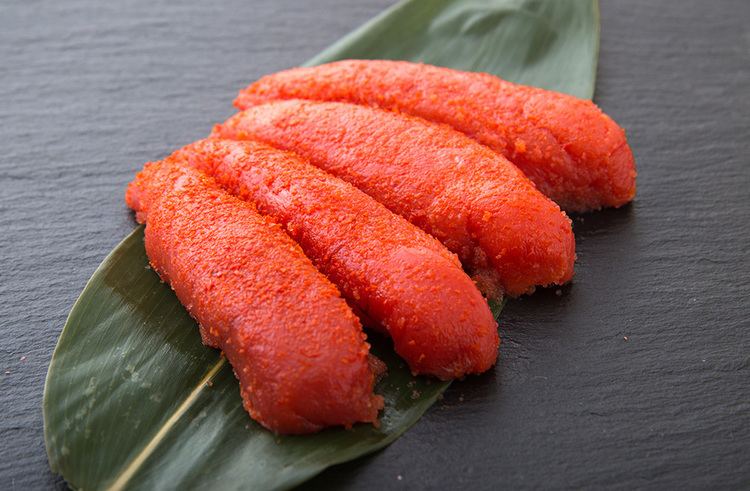Hangul 명란 McCune–Reischauer myŏngnan | Hanja 明卵 Revised Romanization myeongnan Hangul 명란젓 | |
 | ||
Similar Jeotgal, Gejang, Jogi jeot | ||
Pollock Roe, the salted roe of Alaska pollock, is a popular culinary ingredient in Japan, Korea, and Russia. In Korea, the roe of Alaska pollock is traditionally called myeongnan (명란), and the salted roe is called myeongnanjeot (명란젓). The food was introduced to Japan after World War II, and is called mentaiko (明太子) in Japanese. The milder, less spicy version is called tarako (鱈子) in Japan. In Russian, it is called ikra mintaya (икра минтая).
Contents
korean food salted pollack roe mentaiko
TARAKO (pollock roe/鱈子-tarako)
Etymology

Myeongnanjeot (명란젓) is a compound of myeong (명) + ran (란) + jeot (젓). The first letter myeong came from myeongtae (명태), the name for Alaska pollocks in Korean. Ran, also pronounced nan, means "egg (roe)". Jeot refers to salted/fermented food.

Mentaiko (明太子) is also a compound. Although Alaska pollocks are called suketōdara (介党鱈) in Japanese, mentai (明太) here, borrowed from its Korean cognate myeongtae (명태), means Alaska pollock. Ko (子) means "child" (or in this case, roe).

Ikra (икра) means "roe" and mintaya (минтая) is the singular genitive form of mintay (минтай), which means Alaska pollock. The word mintay (минтай) derived from its Korean cognate, myeongtae (명태).
Korea

Koreans have been enjoying pollock roe since the Joseon era. One of the earliest mentions are from Seungjeongwon ilgi (Journal of the Royal Secretariat), where a 1652 entry stated: "The management administration should be strictly interrogated for bringing in pollock roe instead of cod roe." Recipe for salted pollock roe is found in a 19th century cookbook, Siuijeonseo.
Japan
Toshio Kawahara (川原 俊夫, Kawahara Toshio), who was born in the city of Busan, Korea during the Japanese occupation, adapted mentaiko to Japanese tastes in Fukuoka in 1949. The typical seasoning and flavor is different in Japan.
Korea
Traditionally, myeongnanjeot was made before dongji (winter solstice). Intact skeins of Alaska pollock roe are washed carefully with salt water, then salted in a sokuri (bamboo basket). The ratio of salt to roe ranges from less than 5:100 to more than 15:100. After 2-3 days, salted and drained roe is marinated for at least a day with fine gochutgaru (chilli powder) and finely minced garlic. Myeongnanjeot is usually served with some drops of sesame oil.
Myeongnanjeot, whether raw, dried, and/or cooked, is a common banchan (side dish) and anju (food served with alcoholic beverages). It is also used in a variety of dishes, such as gyeran-jjim (steamed egg), bokkeum-bap (fried rice), and recently in Korean-style Italian pasta dishes.
Myeongnanjeot is a specialty of South Hamgyong Province of North Korea, and Gangwon Province and Busan of South Korea.
Japan
Mentaiko is made in a variety of flavors and colors and is available at airports and main train stations. It is usually eaten with onigiri, but is also enjoyed by itself with sake. A common variety is spicy mentaiko (辛子明太子, karashi mentaiko). It is a product of the Hakata ward of Fukuoka City.
Recently in Japan, mentaiko pasta has become very common and popular. Mentaiko is mixed with butter or mayonnaise and used as a sauce for spaghetti. Thin strips of Nori are often sprinkled on top.
Mentaiko was nominated as Japan's number one side dish in the Japanese weekly magazine, Shūkan Bunshun.
Russia
In Russia, pollock roe is consumed as a sandwich spread. The product, resembling liquid paste due to the small size of eggs and oil added, is sold canned.
